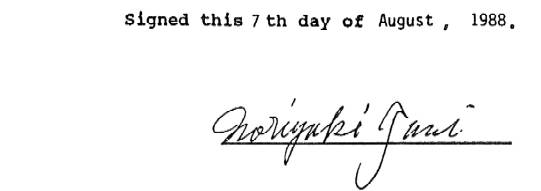Affidavit of Dr. Tani
DECLARATION
IN THE UNITED STATES PATENT AND TRADEMARK OFFICE
| Ref. application of: Y. Omura, M.D., ScD. | |
| Serial No. 06/785,495 | Examiner: J. Hanley |
| Filed: October 8, 1985 | Group No. 335 |
For: Bi-Digital O-Ring Test for imaging and diagnosing internal organs of patients
DECLARATION
Washington, D.C. 20231
Sir:
I, Noriyuki Tani, D.D.S., Ph.D., Associate Prof. of Dental School, Meikai University, a Japanese citizen residing at 2-15-4 , Nishisakado, Sakado City, Saitama Prefecture, Japan, declare:
I was born May 22, 1945 in Saitama, Japan.
In 1969 I graduated from Osaka Dental College.
In 1969 I was appointed as an instructor of the Seijo Dental College.
In 1980 I was appointed as an associate professor of the Seijo Dental College.
In 1981 I received a Ph.D. in electro-physiology from Osaka Dental College. The title of my thesis was "The Autocorrelogram and Power Spectrum of the Brain Wave at the Time of the Resting Position of the Mandible."
In 1988 I became an associate professor of Meikai University Dental School, as Seijo Dental College became part of Meikai University.
In order to apply the Bi-Digital O-Ring Test to the dental field supported by a scientific basis, I have been doing a basic experiment from the viewpoint of cerebral neurophysiology, as I attended his seminars & workshops 5 times in 4 years and was deeply impressed by Dr. Omura's Bi-Digital O-Ring Test research and clinical demonstrations. I personally witnessed about 25 of these clinical demonstrations. They were done with well-studied patients brought by other doctors, supported by good laboratory documentation from the other doctors. Dr. Omura was given very little information about the patients, other than vague symptoms and locations, and he used his Bi-Digital O-Ring Test to identify and localize the disorders, which ranged into both medical and dental areas. In order to explain the fundamental mechanisms of the Bi-Digital O-Ring Test, I then began the following electrophysiological experiment. According to Dr. Omura's work, using the Bi-Digital O-Ring Test, an abnormal part of the body can be detected when any of the following stimulations is given:
- Mechanical stimulation
- Positive electrical field
- Magnetic field (polarity depends on the different parts of the body)
- Electro-magnetic waves (including a light beam of either white light or monochromatic light with a wave length longer than specific wave length of the green color)
Since the first 3 modes of stimulation have been studied by others, I concentrated on the effect of the radiation of the light beam on the body surface. Our study with a radiation of a very weak light beam of 80 Luxe on an abnormal part of the body was detected by the brain and was measureable as a change in the spectrum component of EEG of the human brain. Some of my research has been presented during the 1st Annual Symposium on the Bi-Digital O-Ring Test, held in July, 1987 and the 2nd Annual Symposium on the Bi-Digital O-Ring Test, held in July, 1988 in Tokyo (both of which were organized by the Japan Bi-Digital O-Ring Test Association), as well as during the Bi-Digital O-Ring Test Symposium of the 3rd International Symposium on Acupuncture and Electro-Therapeutics held at Columbia University School of International Affairs during October 8-11, 1987.
We have been extensively using the Bi-Digital O-Ring Test in the dental clinic of our institute for the past three years for diagnosis of various facial and oral problems, and it has been particularly helpful in detecting and localizing bacterial or viral infections and selecting effective and safe antibiotics as our previous laboratory tests often confirmed the accuracy of the Bi-Digital O-Ring Test.
It has become a routine procedure for the evaluation of temporo-mandibular problems. It is particularly helpful in localizing the exact location of hidden problems which are difficult to pinpoint.
Furthermore, many dentists in Japan have started using the Bi-Digital O-Ring Test to prevent serious allergic response and shock by injecting local anesthetic, since Dr. Akira Fukuoka, D.D.S., Sc.D., of Tokyo published articles in Japanese dental journals indicating that all his patients who had a history of strong reaction to the injection of local anesthetic for the dental proceedure also showed striking response to Bi-Digital O-Ring Test, and therefore the Bi-Digital O-Ring Test can be used as a quick and simple screening method of detecting potential allergic reaction to local anesthetic before injecting it in patients. Since our experience with the Bi-Digital O-Ring Test has proven it to be a very simple, inexpensive and accurate diagnostic method, without use of sophisticated instruments, we have been teaching the Bi-Digital O-Ring Test and its imaging method as one of the most important diagnostic methods for our dental students, as well as for dentists who attend our post-graduate courses, for which I am a faculty member.
The undersigned declarant declares further that all statements made herein of his own knowledge are true and that all statements made on information and belief are believed to be true: and further that these statements were made with the knowledge that willful false statements and the like so made are punishable by fine or imprisonment or both, under section 1001 of Title 18 of the United States Code and that such willful false statements may jeopardize the validity of the application or any patent issuing thereon.
